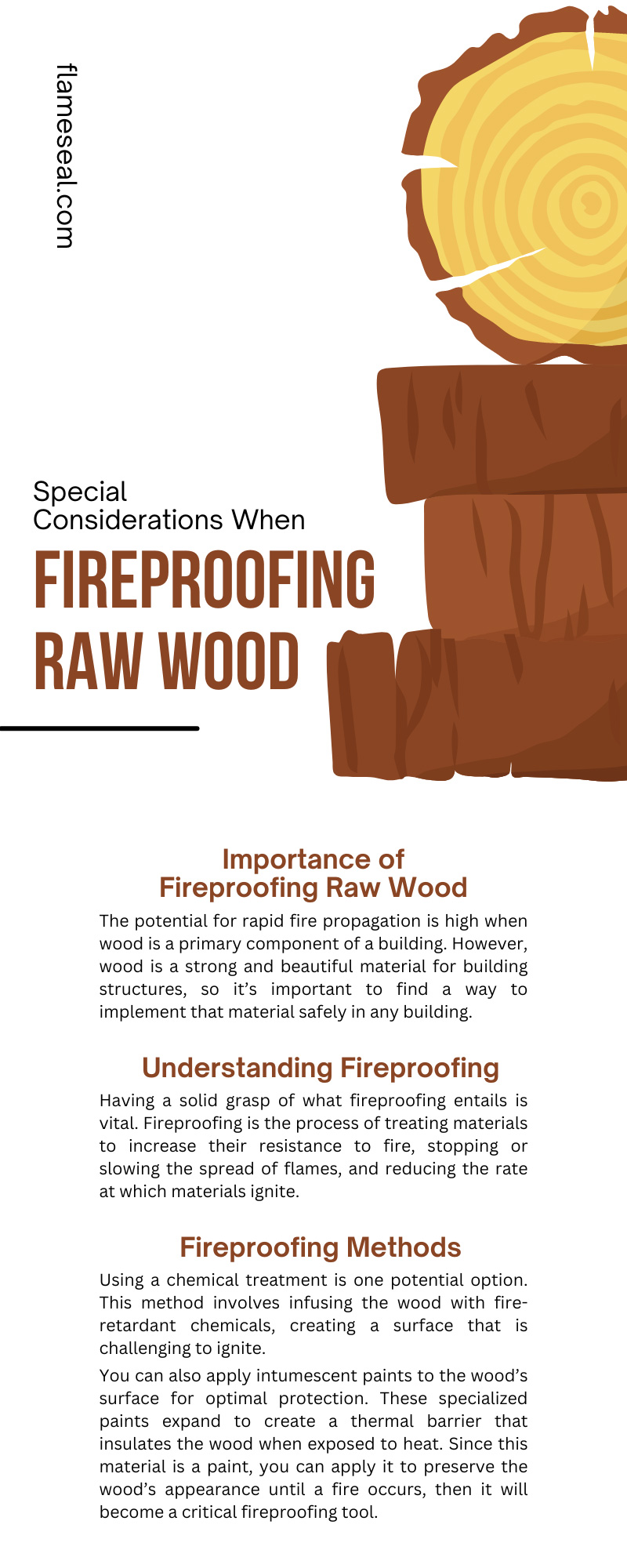
The fireproofing of materials is a critical aspect of safety that one cannot overlook in the construction and renovation industries. Amid the array of fireproofing challenges, raw wood stands out as a material that can offer both aesthetic appeal and essential fire resistance when treated correctly.
However, fireproofing raw wood comes with a set of nuances and considerations that anyone in the building trade must be fully aware of. This comprehensive guide will take you through the special considerations when fireproofing raw wood so you can use it to build safer structures.
Importance of Fireproofing Raw Wood
The potential for rapid fire propagation is high when wood is a primary component of a building. However, wood is a strong and beautiful material for building structures, so it’s important to find a way to implement that material safely in any building.
Through the application of fire-retardant treatments, you can transform raw wood into a material that offers significantly reduced flammability, buying critical time for evacuation and intervention in the event of a fire. Understanding how to start fireproofing raw wood can be the difference between a minor incident and a catastrophic event.
Understanding Fireproofing
Having a solid grasp of what fireproofing entails is vital. Fireproofing is the process of treating materials to increase their resistance to fire, stopping or slowing the spread of flames, and reducing the rate at which materials ignite. Several methods exist, to ensure you can utilize wood’s strength and beauty safely. Let’s dive into the best fireproofing methods you can use to treat raw wood.
Fireproofing Methods
Using a chemical treatment is one potential option. This method involves infusing the wood with fire-retardant chemicals, creating a surface that is challenging to ignite.
You can also apply intumescent paints to the wood’s surface for optimal protection. These specialized paints expand to create a thermal barrier that insulates the wood when exposed to heat. Since this material is a paint, you can apply it to preserve the wood’s appearance until a fire occurs, then it will become a critical fireproofing tool. It’s important to remember that these materials don’t extinguish or stop flames entirely, but they can provide more than an hour of protection depending on the coating you use.
Builders can also opt for fire-resistant panels to better equip their structures for fire emergencies. They can use materials like gypsum or cementitious coatings as a shield to protect the wood, delaying the spread of fire. Implementing a fireproofing method depends on the construction type, the desired fire resistance level, and local building regulations.
Factors To Consider When Fireproofing Raw Wood
Fireproofing is not a “one-size-fits-all” solution, and this is particularly applicable to raw wood. Thus, we will introduce you to several key factors to consider so you can provide buildings with the protection they need. The type of wood being used, the choice of fireproofing products, and the environmental impact of these treatments are critical factors that you must carefully assess.
Type of Wood
Different species of wood can have varying levels of natural fire resistance. Hardwoods, for instance, are generally more fire-resistant than softwoods.
Additionally, you must properly note the presence of any surface finishes or treatments on the wood because they can influence how fire-resistant the wood is. As the name suggests, raw wood does not have any finishes on the surface, ensuring it’s the perfect base for you to start building a fireproofing strategy.
Fireproofing Products & Treatments
Quality and compatibility are non-negotiable when it comes to selecting a fireproofing product. Poor product selection can lead to a lack of proper fire protection or even damage to the wood. Look for fireproofing treatments that manufacturers specifically designed for wood and have tested them thoroughly to ensure they meet regulatory standards. Using high-quality fireproofing solutions from trustworthy manufacturers ensures you can rely on them when the building inhabitants need fire protection the most.
Regulations & Standards
Like choosing quality fireproofing products, compliance with local building codes and fire safety standards is mandatory and non-negotiable. These regulations dictate the type and intensity of fire resistance that one must achieve in various building elements.
Awareness and adherence to these standards must be at the forefront of any fireproofing endeavor when using raw wood as the building material. For instance, at Flame Seal, our fire retardant treatment for woodis compliant with Class A standards established by the IBC (International Building Code).
Understanding the legal framework that governs fire resistance in construction is paramount. Consult fire inspectors, engineers, and other qualified professionals to ensure that your building materials and plans meet all legal fireproofing requirements.
Best Practices for Fireproofing Raw Wood
The application of fireproofing treatments is a skilled task that you must execute with precision with raw wood. Mistakes in application can undermine the fireproofing treatment’s effectiveness and even lead to safety hazards.
You must carefully apply fireproofing treatments in a controlled environment, following the manufacturer’s guidelines. Temperature, humidity, and the wood surface’s condition are key factors in ensuring you apply the treatment correctly. Using experienced professionals or consulting the treatment manufacturer directly can be invaluable for guidance on proper application.
Maintenance & Reapplication
The durability of fireproofing treatments can vary, and regular maintenance is necessary to ensure ongoing protection. Fireproofing material can experience gradual exposure for various reasons, whether from direct damage or due to a building renovation.
Inspections and reapplications must be part of the routine maintenance plan for any structure containing wood. Prioritize maintenance for fireproofing materials to ensure building occupants always have a protective barrier that will delay the spread of smoke and flames during an emergency.
Building With Precision & Safety
The process of fireproofing raw wood is both an art and a science. It requires a keen understanding of materials, an adherence to stringent regulations, and a commitment to safety.
The special considerations when fireproofing raw wood will help you construct buildings with the knowledge you’ll need to keep occupants safe. Builders and contractors can approach the fireproofing of raw wood with knowledge and confidence with the information provided in this guide, contributing to the creation of safer built environments.

